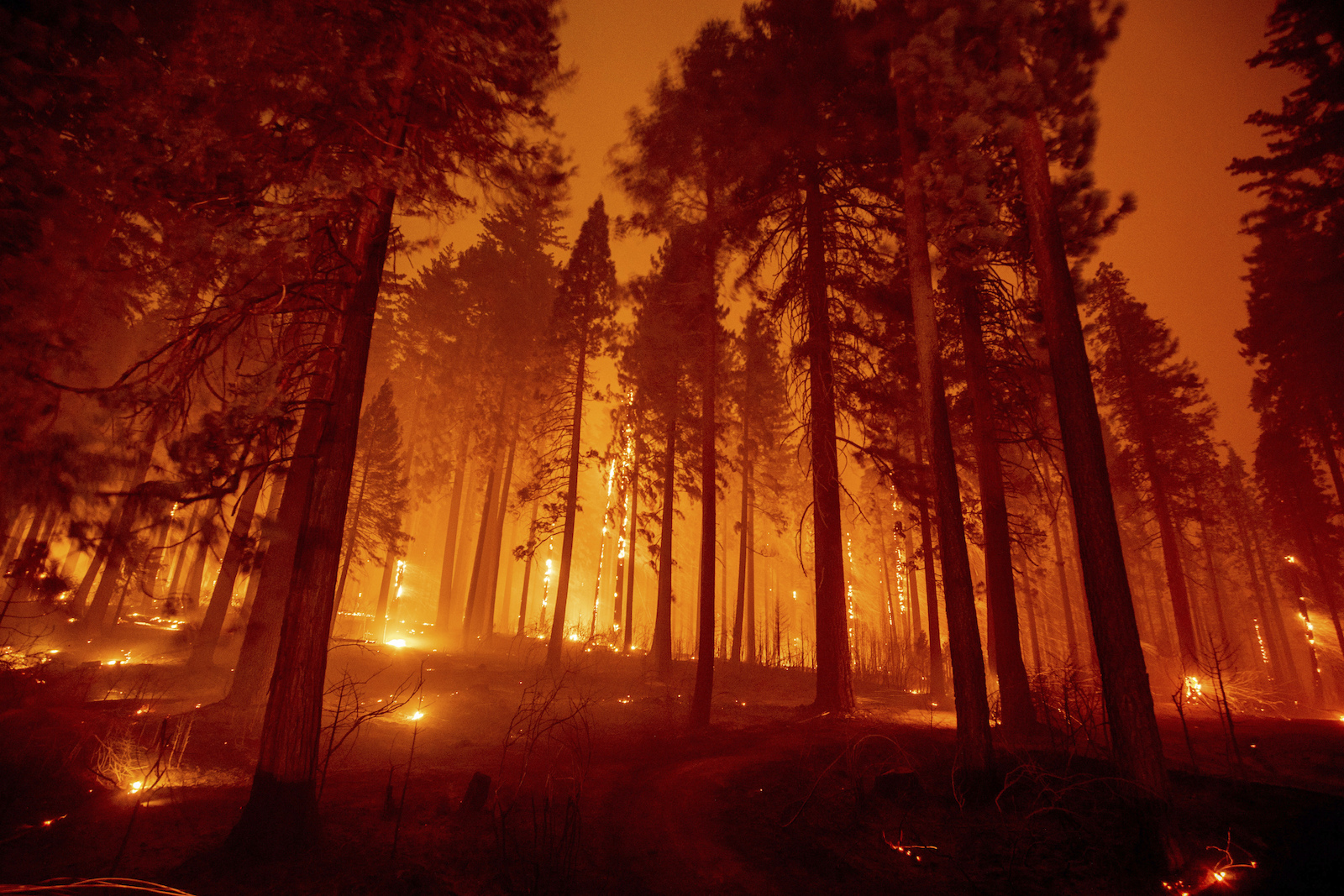California is banking on forests to reduce emissions. What happens when they go up in smoke?
Oct 27, 2021
On a simmering afternoon in late July, against a hazy background of sun and sky, the Colville Indian Reservation was burning. Again.
The Summit Trail Fire, sparked by lightning, was scorching the upper northeast reaches of the reservation, spreading over 4,000 acres in a matter of days. As hundreds of firefighters worked to keep it contained, flames raced through fallen leaves and twigs, dead logs, and Douglas firs.
It wasn’t the first fire of the summer for Colville. The 1.4 million-acre reservation, which hugs the banks of the Columbia River in northeastern Washington, was also under siege by the Chuweah Creek fire, which started around the same time. Previous fire seasons had been even more devastating. In 2020, over 200,000 acres had burned. And five years earlier, two blazes ripped through 270,000 acres, roughly 20 percent of the reservation, displacing thousands and costing approximately $36 million in damages.
In some ways, the Summit Trail Fire was nothing unexpected. The past few years have seen record-breaking fire seasons in the American West, with blazes scorching more than 10 million acres in 2020. Climate change is partly to blame: Scientists estimate that since the mid-1980s, high temperatures and drier landscapes have doubled the area burned in the West.
But Colville was different in one crucial way: The Douglas firs and other conifers peppering the reservation were not just there to be turned into lumber, or for the tourists and residents who hike and camp along the southern half of the Kettle mountain range. Those trees were also intended to combat climate change by storing millions of metric tons of carbon in their trunks and leaves. The Confederated Tribes of Colville had enrolled sections of their forest in California’s state-run carbon offset market in 2015, effectively promising that the extra carbon stored in those trees would stay there for at least 100 years, canceling out some of the emissions of fossil fuel companies. And as the flames raced through the reservation, encircling tree trunks and burning through undergrowth, some of that stored carbon was spilling out.
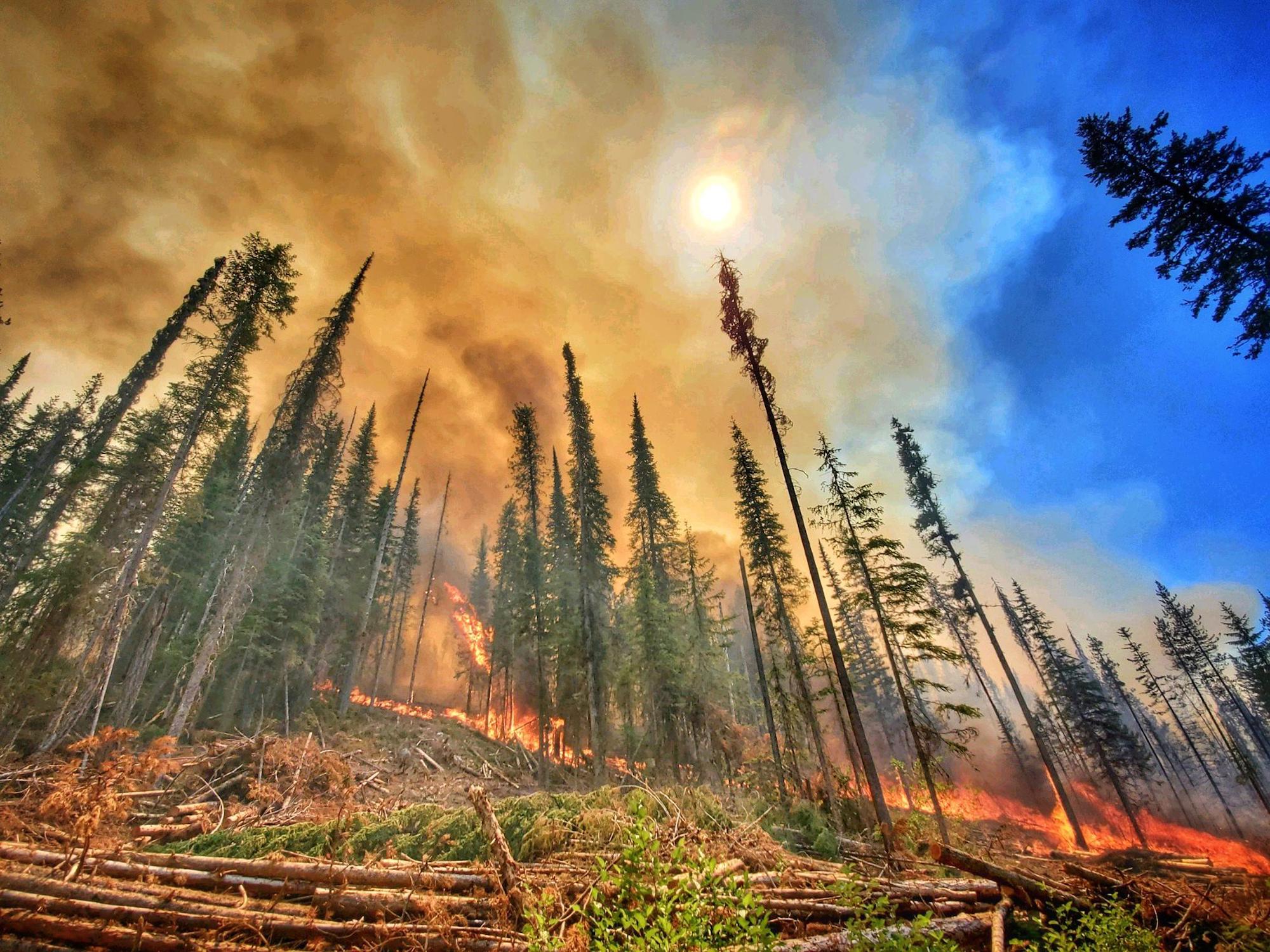
Colville is not the only offset project to be struck by fire in recent years. According to the nonprofit CarbonPlan, which analyzes the scientific integrity of carbon offsets, at least six large sites in California, Oregon, and Washington have burned over the past five years. The California Air Resources Board, which oversees the state’s offset market, has an insurance system designed to protect against such disasters. But a growing number of forest ecologists, climate modelers, and policy experts argue that the insurance system, known as the “buffer pool,” was never based on sound science — and that now, as forests burn more severely and frequently across the West, it could be in danger of collapse.
That could have wide-ranging consequences, far beyond derailing a few isolated projects. The forests enrolled in California’s offset market currently store more than 190 million extra metric tons of carbon dioxide. If the buffer pool fails, and forests continue to burn, millions of tons of CO2 could be released into the atmosphere, threatening to undo much of the state’s climate progress.

The logic underlying a carbon offset is simple: a ton of carbon is a ton of carbon, anywhere in the world. Because carbon dioxide is well-mixed in the atmosphere, the CO2 emissions of a plane flying from New York City to London could be canceled out by tree growth in Brazil.
Anyone can buy carbon “credits” voluntarily: Companies purchase them to cancel out their planet-warming emissions. Individuals can buy them to alleviate guilt over a long-distance flight or a gas-guzzling car. But in California, companies can purchase offsets as a way to comply with local law. In 2006, the state passed a landmark climate law, AB 32, which set a steadily shrinking “cap” on carbon emissions throughout the state. It requires companies operating in California to buy permits to pollute — or instead, to buy offsets to cancel, on paper, between 4 to 8 percent of the emissions from their oil refineries, power plants, and other polluting sites. Other states, including Washington, are currently considering or building their own cap-and-trade programs, and are likely to look to California’s system as a model.
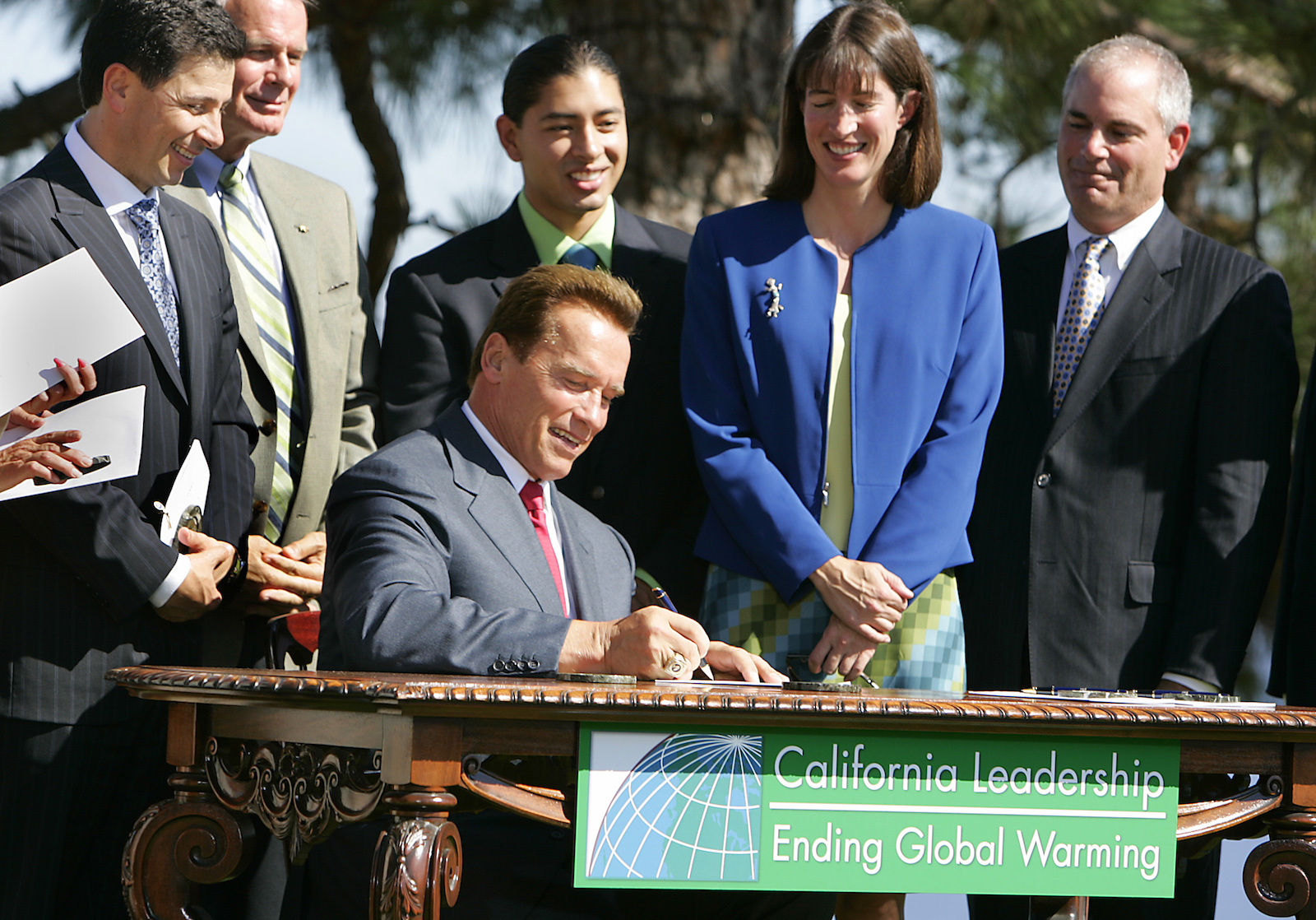
Ken Hively/Los Angeles Times via Getty Images
In theory, an offset could take many forms: a clean energy project, or a new way of handling methane-emitting animal waste. But most of the California offset market is in “improved forest management,” meaning forests managed by landowners to suck up more carbon from the atmosphere than they otherwise would. (That’s also true for offset projects around the world. According to the Berkeley Carbon Trading Project’s Voluntary Offsets Database, nearly half of the world’s registered offset projects involve storing carbon in trees.) Under California’s rules, a landowner can earn one carbon credit for every metric ton of carbon their trees store above what comparable forests in the area contain.
The system seems like a win-win: For companies trying to abide by emissions rules, purchasing carbon credits is often cheaper than actually trying to stop CO2 from spewing into the atmosphere. Selling them can also be lucrative for landowners. Offsets currently go for around $14 per credit, and deals can involve millions of credits. In 2015, the Colville Tribes landed a deal to sell an estimated $80 million worth of their prospective credits to the oil company BP.
The problem is that many of these forest projects are located in the already scorched West, at a time when fire risk is getting worse. And some of the projects enrolled in California’s program are already burning up.
In 2015, a fire ran through an offset project in Northern California called Trinity Timberlands, releasing all of the extra carbon that was supposed to be stored in the forest. Another California project, Eddie Ranch, lost 99 percent of its credits to fire in 2018. And last year, the Lionshead Fire burned through another project on the Warm Springs Indian Reservation in northern Oregon. The loss in terms of credits hasn’t yet been calculated — California gives landowners two years after a fire to assess the damage — but according to a CarbonPlan analysis, the fire hit almost two-thirds of the project area.
In designing California’s offset market, the Air Resources Board understood that there were risks to storing carbon in trees. To safeguard the program, the state agency ordered all forest project owners to not sell a percentage of their credits, and set them aside in something called the “buffer pool.” That way if trees are lost — whether due to fire, bankruptcy, illegal logging, disease, or pests — the state can pull extra credits out of the buffer pool to make up the difference. About 850,000 credits were pulled out of the buffer pool to compensate for the fire at Trinity Timberlands, and almost 300,000 for the Eddie Ranch fire. In theory, as long as there are enough credits in the bank to compensate for the carbon lost from burned trees, the system will continue to work.
But experts warn that the share of credits set aside for fire risk is much too small, and does not take into account regional differences. Every landowner has to contribute 2 to 4 percent of their credits to the buffer pool for the possibility of fire — numbers that scientists say don’t seem to account for historical fire risk, let alone the risk under a rapidly changing climate.
Colville, for instance, has yet to tally the cost of fires over the last two years, but it’s one of the largest projects in California’s system, worth more than 14 million credits, or roughly half the size of the existing buffer pool.
Between 2011 and 2019, the state of California only reduced its CO2 emissions by about 25 million metric tons. If the buffer pool is wiped out — and offset projects continue to burn — the carbon released could put a significant proportion of the state’s progress in jeopardy.
According to a recent study from researchers at the University of Utah, the University of California, Santa Cruz, and CarbonPlan, the risk of a moderate to severe fire in the U.S. — which they define as one that releases at least one-fifth of the carbon stored in the forest — is in the range of 8 to 10 percent. And in the West, where record wildfires have raged over the past several years, the odds of a severe fire are even higher.
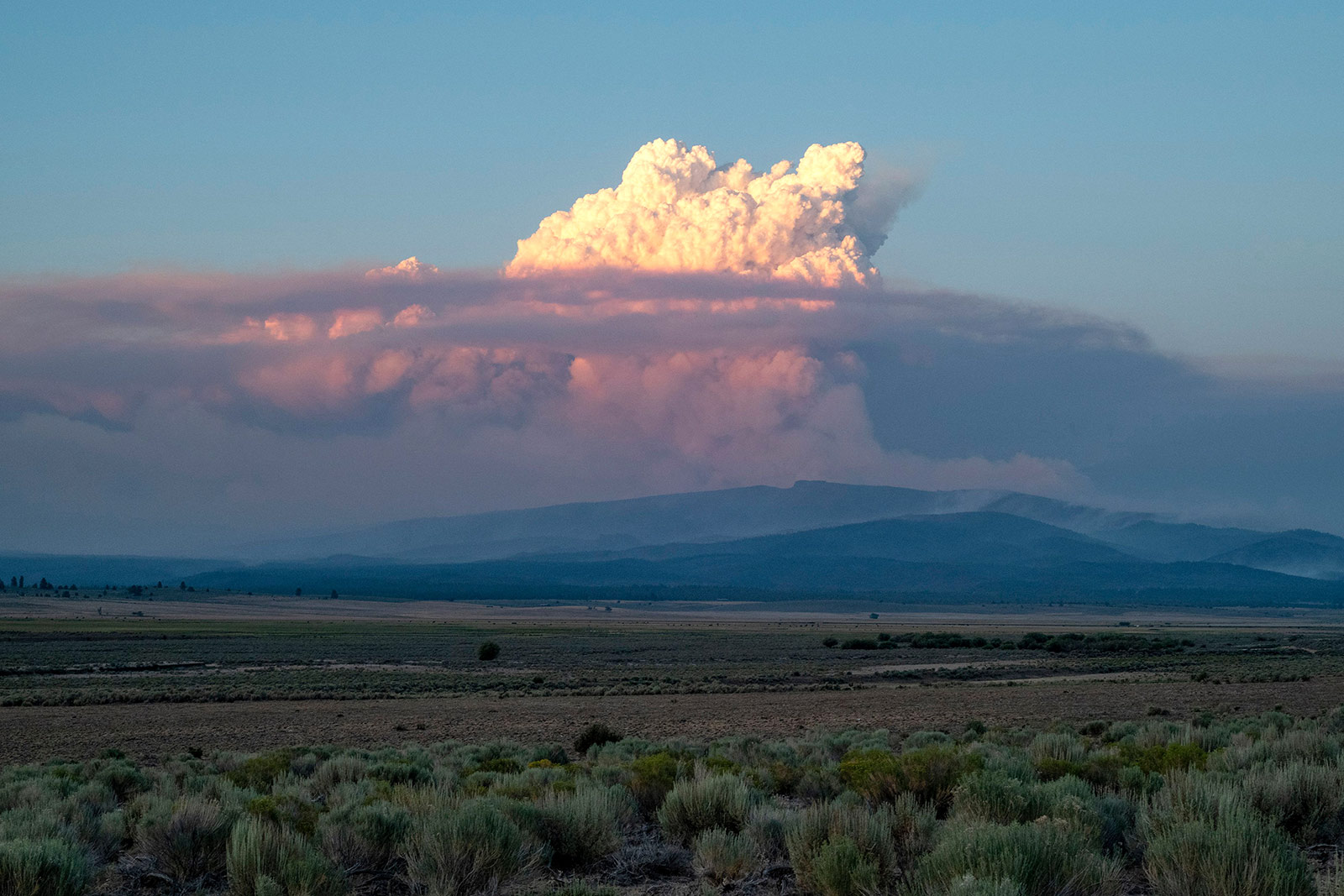
Ayton Bruni / Getty Images
Bill Anderegg, an associate professor of biological sciences at the University of Utah and one of the authors of the paper, says that the analysis has made him question whether the buffer pool is big enough. “It’s abundantly clear how high the risks are in the Western U.S. — and there are a huge number of offset projects in those high-risk areas,” he said.
Climate change only exacerbates the problem. Another analysis from scientists at the University of California, Irvine, found that in a scenario in which the world took only moderate action to curb global warming — essentially, the planet’s current warming pathway — changes in temperature and precipitation could drive ecosystems along the Northern California coast and in the southern Cascades region to lose 6.5 percent of their above-ground carbon. That area happens to be home to 32 California forest carbon projects.
Researchers at CarbonPlan, meanwhile, have recently estimated that by the end of the century, overall fire risk in the U.S. could increase by a factor of 4 to 14, depending on action to slow CO2 emissions. (That paper is currently undergoing peer review.) Only about 28 percent of the forestry-related carbon credits in California’s market are tied to trees in California, Oregon, and Washington. The rest are on the East Coast, in Alaska, or scattered across the country. But the new study suggests that trees in the rest of the country could become just as vulnerable. “Parts of the Southeast start to look like California by the end of the century,” said Oriana Chegwidden, a climate scientist at CarbonPlan and one of the authors of the study.
Scientists say that you can’t simply take the risk of a wildfire and turn it into a prediction of exactly how much carbon could be lost. Fires are not atomic bombs; they don’t obliterate everything they touch, and even burned forests still store a substantial amount of carbon. But almost all of the researchers Grist spoke to agreed that the 2 to 4 percent of credits landowners have to set aside seemed too low. Matthew Hurteau, a forest ecologist at the University of New Mexico, said that he has been worrying about the risks of fire to offsets for over a decade. “Those of us who do research on this topic have seen this coming for a long time,” he said.
Landowners’ contribution to the pool varies between 2 and 4 percent depending on how well they protect their forests from wildfire. But some landowners receive a low, 2 percent rating for fire risk despite a history of fire. In 2015, the Confederated Tribes of Colville registered their forest on the California offset market — the first step in bringing offsets to market. Later that year, devastating fires swept through part of the proposed project. Afterward, the tribes moved forward with their offset plan and still received a 2 percent fire risk rating on the California market despite the recent burns.
Grayson Badgley, a postdoctoral fellow at Columbia University, said even if landowners took “heroic efforts” to reduce standing fuel in Western forests, the current buffer pool is inadequate. “What is the actual risk of burning between now and over the next 100 years?” he said. “It’s not 2 percent. So the real question that comes to my mind is where did that number come from — and is it right?”
It’s a question with a high-stakes answer. The right number could help keep the system running. The wrong number could push it toward collapse, upending a cornerstone of California’s climate efforts and threatening to warm the planet even more.

When the buffer pool was conceived over a decade ago, it was in some ways an experiment. Wildfire science was not as advanced as it is today, and researchers didn’t yet understand exactly how a warming climate would reshape forests and fire. U.S. offset programs were still in their infancy, and there was no standard way to insure projects against disasters.
“The idea around climate risks, climate impacts, and insurance is a very current conversation now,” said Michelle Passero, the director of climate policy at The Nature Conservancy. “We were having this conversation back in 2008, where there was really no precedent for it.”
When the California carbon offset market launched in 2013, it did so with rules pulled from a voluntary carbon offset registry run by the Climate Action Reserve, which has provided offsets for companies like Delta Airlines. Initially, the Reserve didn’t have any insurance mechanism for protecting forests against fire, disease, or pests. The rules simply required landowners to report how much carbon was in their forest on an annual basis. But in 2008, the Reserve began a multiyear process to make its rules more rigorous and gathered together a group of potential project developers and government officials who met every month to discuss possible changes. One of the goals was to figure out how the program could better guarantee “permanence” — that is, how to ensure that the promised carbon would still be stored in trees a century later.
Leading the overhaul at the Climate Action Reserve was a forester named John Nickerson, who was a consultant for the Reserve at the time. Nickerson told Grist that the group first spoke with global reinsurance giants such as Swiss Re, considered experts in assessing risk, to see if they would insure offset projects, but they didn’t come up with any solutions.
Instead, the group moved forward on adopting a “buffer pool” system, which had already been pioneered by the Verified Carbon Standard, an international offset registry based in Washington, D.C. This required them to come up with a list of all the risks to forest projects enrolled in California’s program and a method for landowners to calculate what their contribution to the buffer pool would be for each one.

Eric Zamora/VW PICS/Universal Images Group via Getty Images
To determine how much to set aside for wildfires, Nickerson said they consulted with scientists, including Hurteau, the forest ecologist. Hurteau urged the group to use a method he proposed in a 2009 paper that would involve calculating the historical risk of fire at each offset site — thus taking into account projects that, like Colville, were in areas at risk of burning over and over again. But the group shied away from this approach, telling Hurteau that it would be too expensive for individual project developers to hire experts to do those calculations. If offset prices were too high, after all, companies might not buy them.
Instead, Nickerson’s group came up with their own estimates. Some of the ratings they landed on were static. The risk of tree disease or insect outbreak was set at 3 percent, for example, and the risk of tree death due to a hurricane or storm also at 3 percent. Others varied: The group assigned a standard fire risk of 4 percent to all projects, but developers would be able to downgrade it to 2 percent if they showed they were taking steps to prevent fire, like clearing the forest floor of brush or building fuel breaks. Ultimately, each project had to place a total of 11 to 20 percent of its credits in the buffer pool.
No rigorous analysis went into the 4 percent number for wildfire. A forest conservationist in the working group named Connie Best said the rule of thumb at the time was that the average risk of a fire occurring anywhere in the U.S. was around 1 percent. However, that doesn’t say anything about how much carbon is lost in the blaze. Trees in the Pacific Northwest, for example, like Douglas firs and ponderosa pines, are well-adapted to fire, and it takes a very hot, severe burn to bring them down. Best and Nickerson said the group thought they were being conservative when landing on 4 percent.
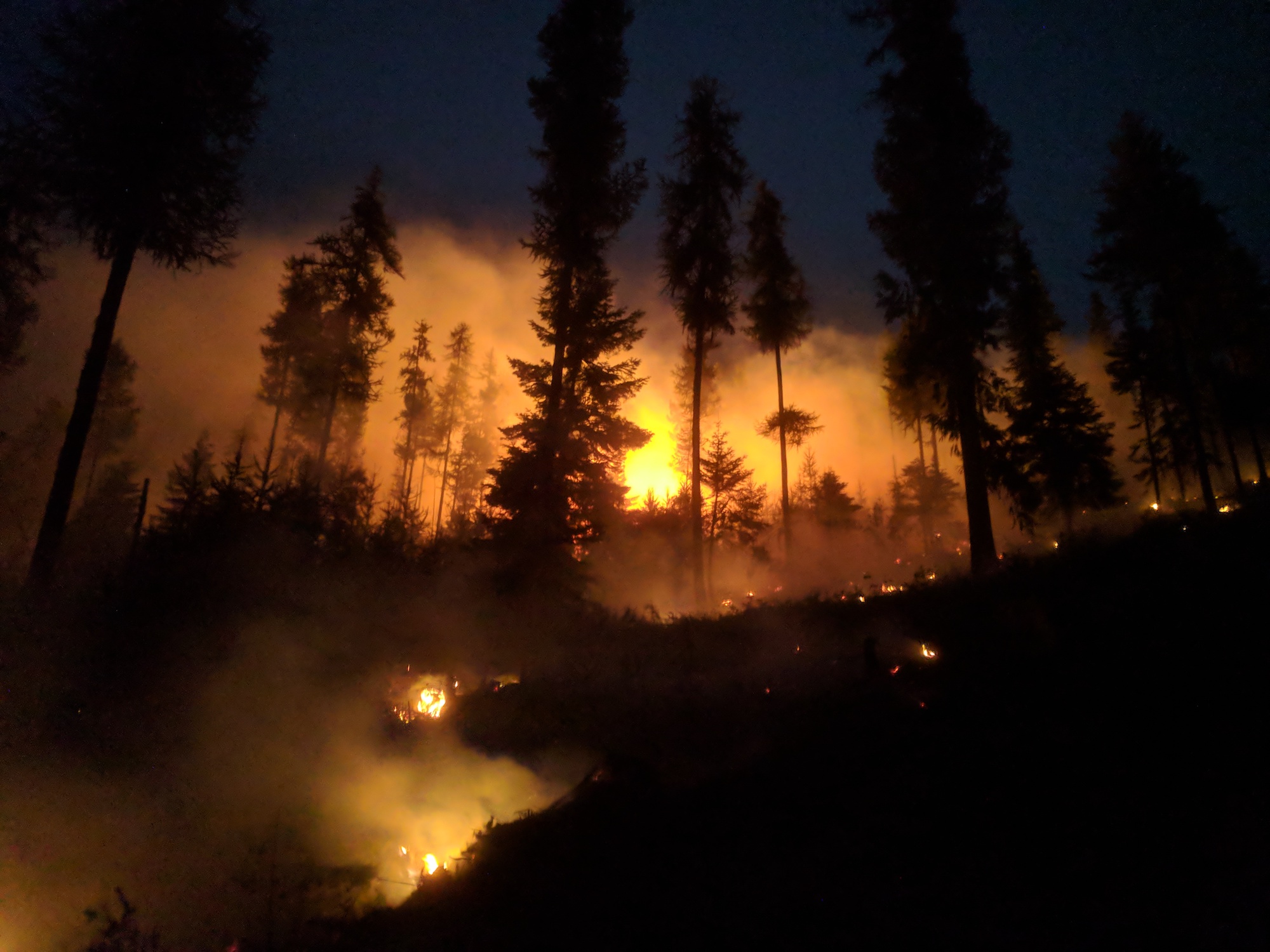
Calvin Hodge / Getty Images
“These risk ratings — they were meant to be reasonable, not precise,” said Best, who is the executive director of the Pacific Forest Trust, a conservation group that also developed one of the earliest forest carbon projects in California. At the time, she said, “there was no ability to be precise.”
The California Air Resources Board adopted the Reserve’s rules virtually unchanged in 2011. During a public comment period beforehand, some raised questions about the proposed buffer pool. Brian Nowicki, California climate policy director at the Center for Biological Diversity, noted that the state provided “no calculations or rationale for the values attributed to the various reversal risks.” (“Reversal” is a technical term meaning the release of carbon from an offset project.) The rules, Nowicki wrote, “fail[ed] to address the liability that reversal of forest projects brings to the offset program as a whole.”
In response, the Air Resources Board described the risk ratings as conservative and noted that they could be adjusted if warranted.
Nickerson and Best said that was always the plan. “We always felt that if there is a problem, we go back and we adjust it just like any insurance company would adjust the premium,” Nickerson said. They both acknowledged that wildfires have grown more frequent over the past decade, but told Grist they have yet to see clear evidence that the numbers need to be adjusted, let alone that the buffer pool is at risk of failing. The Air Resources Board has not increased the buffer pool’s fire risk number since its inception in 2011.
To Nickerson, concerns about whether 4 percent is high enough to handle wildfires are misguided. He and Passero, who also worked on the early iteration of the buffer pool, emphasized that just because there is a 4 percent contribution for wildfires does not mean that only 4 percent of the buffer pool can be used to insure against them — any buffer pool credit can be used to compensate for any kind of forest loss, whether from a hurricane, disease, or fire.
The Climate Trust, a nonprofit that buys and sells carbon offsets, did its own rough estimate of carbon loss from the recent fires. In a blog post, the group said that under “moderate to severe fire damage” from wildfires at Colville, Warm Springs, and Klamath East, the buffer pool could lose 6.8 million credits, or almost a quarter of the total 30 million credits. While that might sound bad, they note that “the buffer pool grows larger every year.”

Kevin Benedict / USFS
Danny Cullenward, the policy director at CarbonPlan, said that logic is faulty. The buffer pool is “a lot like a Ponzi scheme,” he explained. A Ponzi scheme needs a flow of new money to work, with new investors paying off old ones. Cullenward believes it’s a similar story with the buffer pool. “As long as you add more and more projects to the buffer pool, each one can be undercapitalized,” he said.
The problem is that there’s only a limited amount of land in the U.S. suitable for forest offsets — and therefore a limited number of projects. Without new funds flowing in, Ponzi schemes collapse. “What happens when the music stops?” Badgley said. “What happens when there’s not an extra project that gets added?”
“Maybe they didn’t have that much data to base it on,” Anderegg, the University of Utah professor, said of the early buffer pool. “That might have been OK 20 years ago. It really shouldn’t be the case today.”
Some in the offsets industry see the buffer pool as a barrier to entry for landowners, since it takes away credits they could potentially sell, and would like to see it scrapped altogether. Last year, the California Air Resources Board was required by law to form a task force to discuss ways to improve the offset program. In the group’s first draft of recommendations, it advised the agency to actually reduce or eliminate buffer pool contributions for projects that could demonstrate “improved forest resiliency to natural disturbances.”
Anderegg and 15 other scientists sent a letter to the Air Resources Board warning against shrinking the buffer pool, and that recommendation was dropped from the final report. Instead, the task force recommended that the agency consider allowing project developers to use an outside insurance policy — similar to what Nickerson and his colleagues first considered in 2008.
Nowicki of the Center for Biological Diversity had been appointed to the task force, but resigned, alleging that the group’s recommendations were “largely a wish list of ideas for expanding and deregulating the offsets program.”
Nowicki told Grist he thinks it’s unlikely that the Air Resources Board will seriously investigate the problems with the offset program without pressure from on high — from the governor’s office or legislature. “It requires a certain amount of political will and courage to be able to look at all of this, and to right the ship,” he said.

To date, there is little understanding of what would happen if the buffer pool actually failed. The agency declined to participate in an interview with Grist for this story and did not respond to an emailed question about what would happen if the buffer pool were completely eradicated by fire. In an emailed statement, Dave Clegern, a public information officer at CARB, said: “We have seen no evidence that the buffer is in danger of depletion, but as we always do, we will continue to look at new science and other information as it becomes available.”
In recent years, forest offsets have come under fire for other reasons. In April 2021, CarbonPlan released an analysis, covered by ProPublica and MIT Technology Review, that found that projects in the California offset market were being systematically over-credited, thanks to a system that allows strategic “cherry-picking” of sites for development. (In California’s rules, a landowner can earn credits if their forest has a higher stock of carbon than a given baseline; evidence suggests that offset developers are strategically placing projects in areas with low baselines.) In the 65 projects analyzed, CarbonPlan estimated that 30 percent of the credits issued — the equivalent of 30 million metric tons of carbon dioxide — had no basis in reality. CARB has stated that it disagrees with this assertion, but has not offered any corrections to the reporting.
The buffer pool presents similar issues. If a project burns down and can’t be replaced by the buffer pool, then hundreds of thousands to millions of tons of carbon dioxide that were supposed to be locked away for a century will come spilling out. And CARB’s isn’t the only forest offset program to use a buffer pool. All major voluntary offset programs — such as the Switzerland-based Gold Standard or D.C.-based Verified Carbon Standard, as well as the Climate Action Reserve — also use a buffer pool system to insure forest projects around the world. A representative from the Verified Carbon Standard told Grist they were currently in the process of updating their risk assessment process for the buffer pool to take into account future climate impacts.
Scientists say that California’s buffer pool could be revised to be more in line with science. But Cullenward, the policy director for CarbonPlan, argues that the main hurdles are not scientific.
“Buyers want high volumes of cheap offsets to reduce the cost of complying with cap-and-trade programs,” Cullenward said. The problem, to him, is that doing things “right” — not just shoring up the buffer pool, but fixing other flaws in the system — could make offsets 5 to 10 times more expensive than they are today.
And for some landowners — especially tribes like those at Colville — offsets seem to be the only option to keep forests standing and garner income at the same time. The Yurok tribe of Northern California has used money generated from California’s program to buy back nearly 60,000 acres of land. The Colville Tribes have used income from their offset program to help regenerate trees lost during the 2015 fires. Representatives from the Confederated Tribes of Colville declined to speak with Grist for this story, citing pending litigation. The tribe is suing the federal government, which is a trustee of the reservation, for failing to adequately protect their forests against wildfire.

Offset income can be “very significant” for tribes, said Michael-Corey Hinton, an attorney and a member of the Passamaquoddy Tribe of Maine. “I’ve seen numbers for carbon offset projects for tribes that range to over $100 million in a single sale,” he added. Hinton helped his tribe enroll in the California carbon offset market in 2016, and argues that without carbon credits, economically disadvantaged tribes would have few ways to bring in cash. “The alternative is cutting the trees,” Hinton said. With offsets, he added, “we can just do what we’ve always wanted to do — which is to live off the land.”
Scientists critical of offsets don’t dispute that it’s important to protect forests. But they argue that linking forest protection to offsets — which allow companies to pollute under the assumption that their emissions will later be sucked out of the atmosphere — is troubling.
Barbara Haya, a research fellow at the Center for Environmental Public Policy at the University of California, Berkeley, says that the main problem with offsets is that they trade a known amount of emissions — the amount released by oil and gas companies — with an unknown amount of reductions. The trees that are expected to survive for a century could catch on fire, die from disease, or simply not accumulate as much carbon as expected. “The whole fiction of offsets is that a ton is a ton is a ton and they’re all equal,” she said. “But they aren’t.”
This story has been updated to include a statement from the California Air Resources Board.
This story was originally published by Grist with the headline California is banking on forests to reduce emissions. What happens when they go up in smoke? on Oct 27, 2021.
